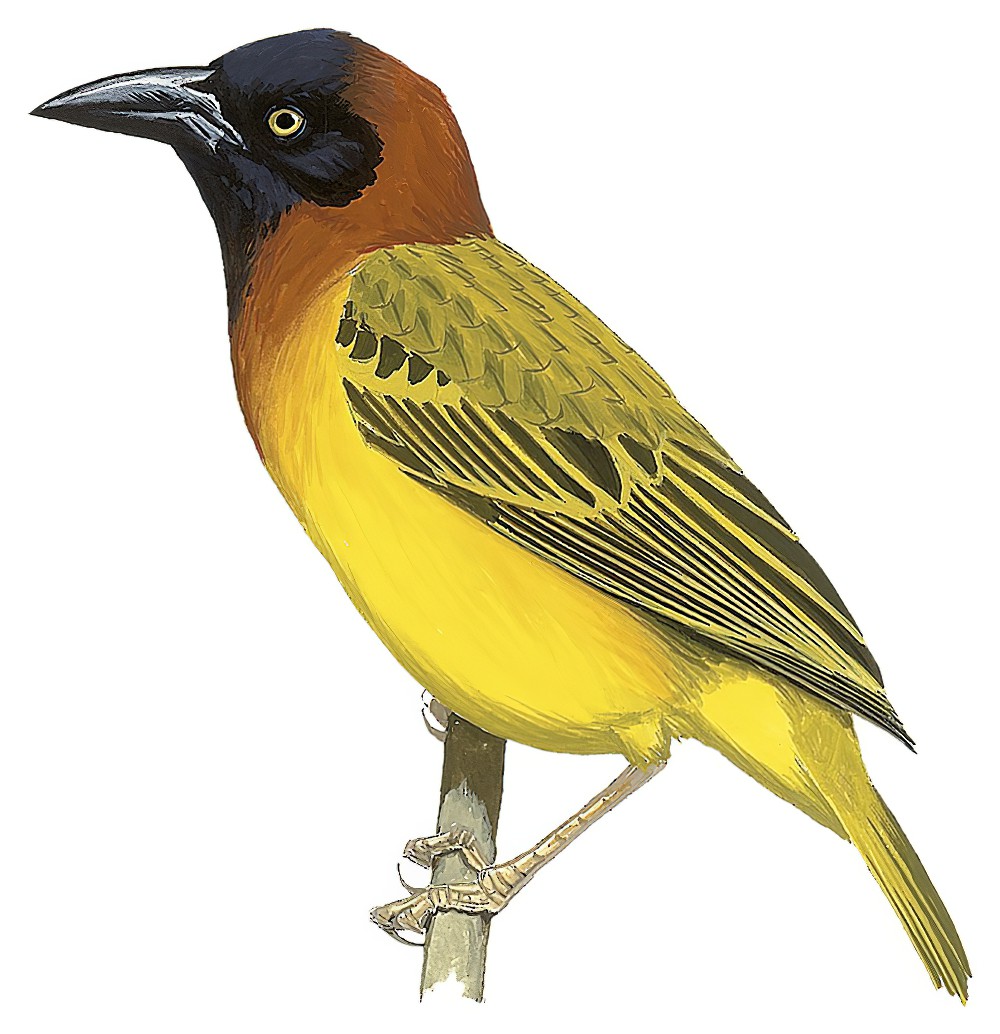Giant Weaver / Ploceus grandis

Giant Weaver
SCI Name:
Protonym: Hyphantornis grandis Gen.Birds 2 Ploceinae p.1
Taxonomy: Passeriformes / Ploceidae / Ploceus
Taxonomy Code: giawea1
Type Locality: Sao Tome.
Author: Gray, GR
Publish Year: 1844
IUCN Status: Near Threatened
DEFINITIONS
PLOCEUS
(Ploceidae; Ϯ Baya Weaver P. philippinus) Gr. πλοκευς plokeus weaver < πλεκω plekō to plait, to entwine; "LES TISSERINS. (PLOCEUS. Cuv.) (2). A bec assez grand pour les avoir fait en partie classer parmi les cassiques; mais sa commissure droite les en distingue. Ils ont de plus la mandibule supérieure légèrement bombée. On en trouve dans les deux continens. La plupart de ceux de l'ancien font leur nid avec beaucoup d'art, en entrelaçant des brins d'herbes, ce qui les a fait nommer TISSERINS. Tel est le Toucnam-Courvi des Philippines. (Loxia Philippina. Lin.) Enl. 135. Jaune tacheté de brun, à gorge noire. Son nid, suspendu, est en forme de boule, avec un canal vertical, et ouvert en dessous, qui communique par le côté dans la cavité où sont les petits (1). Quelques-uns rapprochent leurs nids en grande quantité, pour en former un seule masse à plusieurs compartimens. Tel est le Républicain. (Loxia socia. Lath.) Paterson. Voy. pl. 19. ... (2) Πλοκευς, tisserand. ... (1) Ajoutez le capmore, Buff. (Oriolus textor, Gm.), enl. 375 et 376. — Fringilla erythrocephala, enl. 665. — Le prétendu tangara de malimbe, Daud. An. Mus. I, p. 148, pl. x. — Le baglafecht. (Lox. Abyssinica.) — Le nélicourvi (lox. pensilis), Sonn., 2e Voy. pl. 109." (Cuvier 1817); "Ploceus Cuvier, 1817, Règne Anim., 1, p. 383. Type, by subsequent designation, Loxia philippina Linnaeus (Gray, 1840, List Gen. Birds, p. 42)." (Moreau in Peters 1962, XV, 32). Recent work indicates that the African and Malagasy members of this genus should be included in Malimbus.
Var. Ploceys.
Synon. Bensonhyphantes, Cinnamopteryx, Deignaniplectes, Deleplectes, Dendrhyphantes, Eremiphantes, Eremiplectes, Euploceus, Eupodes, Heterhyphantes, Hypermegethes, Hyphantornis, Hyphanturgus, Hypositagra, Icteropsis, Melanhyphantes, Melanoploceus, Melanopteryx, Microplectes, Microploceus, Nelicurvius, Notiospiza, Oriolinops, Oriolinus, Othyphantes, Pachyphantes, Phormoplectes, Plesiositagra, Ploceella, Ploceolus, Rhinoploceus, Saka, Sharpia, Sitagra, Sitagroides, Sycobrotus, Symplectes, Textor, Thomasophantes, Xanthophilus, Xanthoplectes, Xanthoploceus.
grandis
L. grandis large.
● ex “Lori de la Nouvelle Guinée” of d’Aubenton 1765-1781, pl. 683, “Purpur-roode Lori” of Vosmaer 1769, “Grand Lori” of de Buffon 17770-1783, and “Grand Lory” of Latham 1781 (syn. Eclectus roratus).
● ex “Great Jacamar” of Latham 1782 (syn. Jacamerops aurea).
● ex “Ibijau” or “American Goatsucker” of Ray 1713, “Grand Tette-chèvre tacheté du Brésil” of Brisson 1760, “Grand Crapaud volant de Cayenne” of d’Aubenton 1765-1781, pl. 325, “Grand Ibijau” of de Buffon 1770-1783, and “Grand Goatsucker” of Latham 1783 (Nyctibius).
● ex “Grand Barbu de la Chine” of d’Aubenton 1765-1781, pl. 871, “Grand Barbu” of de Buffon 1770-1786, and “Grand Barbet” of Latham 1783 (syn. Psilopogon virens).
UPPERCASE: current genus
Uppercase first letter: generic synonym
● and ● See: generic homonyms
lowercase: species and subspecies
●: early names, variants, mispellings
‡: extinct
†: type species
Gr.: ancient Greek
L.: Latin
<: derived from
syn: synonym of
/: separates historical and modern geographic names
ex: based on
TL: type locality
OD: original diagnosis (genus) or original description (species)












